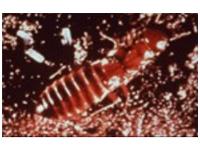Confused Flour Beetle (Also see Rust-Red Flour Beetle)
Granary Weevil (Also see Rice Weevil)
Mediterranean Flour Moth or Mill Moth
Red-legged Ham or Copra Beetle
Rice Weevil (Also see Granary Weevil)
Rust-Red Flour Beetle (Also see Confused Flour Beetle)
Tropical Warehouse or Almond Moth (Also see Warehouse, Tobacco or Cocoa Moth)
Warehouse, Tobacco or Cocoa Moth (Also see Tropical Warehouse or Almond Moth)

Notes
As the name suggests, dampwood termites infest wood with a high moisture content. Dampwood termites are normally larger in size than other termite species. Bodies of king and queen dampwood termites range in size from 1/2 inch to 5/8 inch long and have two pairs of wings that are equal in size and shape and extend beyond their abdomen. Nymphs range up to 5/8 inch and worker dampwood termites are up to 3/4 inch.
Habits
Dampwood termite colonies, like drywood termites, have no worker caste. The nymph dampwood termites take care of the kings and queens of the colony and feed the soldier caste.
Habitat
Because of their need for excessive moisture, dampwood termites are not often found in structures.
Threats
Dampwood termites do not usually infest structures because of the low moisture content of wood in structures. However, care must be taken to avoid attracting dampwood termites to a structure.

